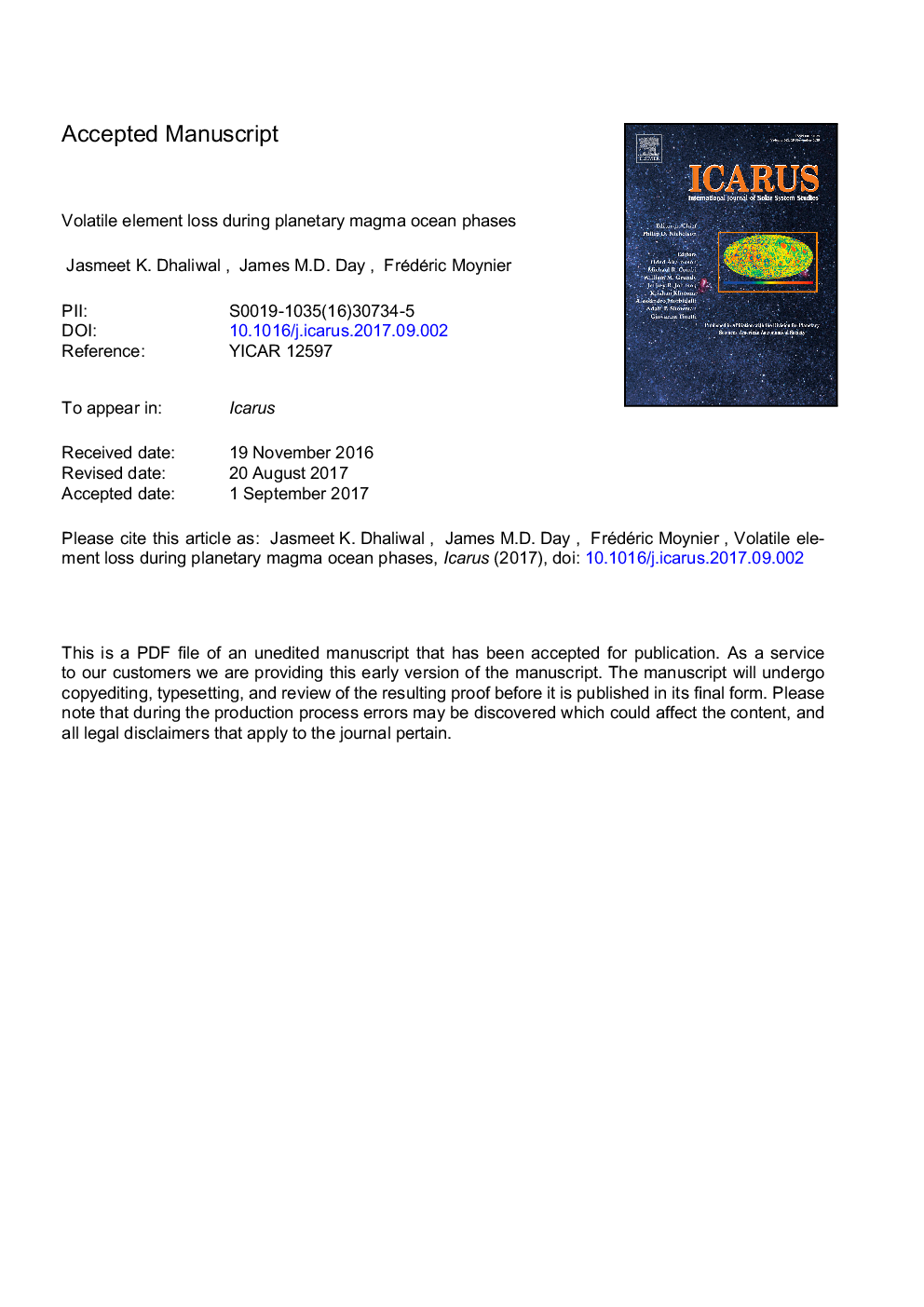| کد مقاله | کد نشریه | سال انتشار | مقاله انگلیسی | نسخه تمام متن |
|---|---|---|---|---|
| 8134701 | 1523491 | 2018 | 42 صفحه PDF | دانلود رایگان |
عنوان انگلیسی مقاله ISI
Volatile element loss during planetary magma ocean phases
ترجمه فارسی عنوان
از دست دادن عنصر فرار در فازهای اقیانوس ماگما سیاره ای
دانلود مقاله + سفارش ترجمه
دانلود مقاله ISI انگلیسی
رایگان برای ایرانیان
کلمات کلیدی
ماه، اقیانوس مگاما، فرار ناچیز، فلز روی، فراوانی ایزوتوپها،
موضوعات مرتبط
مهندسی و علوم پایه
علوم زمین و سیارات
علوم فضا و نجوم
چکیده انگلیسی
Moderately volatile elements (MVE) are key tracers of volatile depletion in planetary bodies. Zinc is an especially useful MVE because of its generally elevated abundances in planetary basalts, relative to other MVE, and limited evidence for mass-dependent isotopic fractionation under high-temperature igneous processes. Compared with terrestrial basalts, which have δ66Zn values (per mille deviation of the 66Zn/64Zn ratio from the JMC-Lyon standard) similar to some chondrite meteorites (â¼+0.3â°), lunar mare basalts yield a mean δ66Zn value of +1.4 ± 0.5â° (2 st. dev.). Furthermore, mare basalts have average Zn concentrations â¼50 times lower than in typical terrestrial basaltic rocks. Late-stage lunar magmatic products, including ferroan anorthosite, Mg- and Alkali-suite rocks have even higher δ66Zn values (+3 to +6â°). Differences in Zn abundance and isotopic compositions between lunar and terrestrial rocks have previously been interpreted to reflect evaporative loss of Zn, either during the Earth-Moon forming Giant Impact, or in a lunar magma ocean (LMO) phase. To explore the mechanisms and processes under which volatile element loss may have occurred during a LMO phase, we developed models of Zn isotopic fractionation that are generally applicable to planetary magma oceans. Our objective was to identify conditions that would yield a δ66Zn signature of â¼+1.4â° within the lunar mantle. For the sake of simplicity, we neglect possible Zn isotopic fractionation during the Giant Impact, and assumed a starting composition equal to the composition of the present-day terrestrial mantle, assuming both the Earth and Moon had zinc 'consanguinity' following their formation. We developed two models: the first simulates evaporative fractionation of Zn only prior to LMO mixing and crystallization; the second simulates continued evaporative fractionation of Zn that persists until â¼75% LMO crystallization. The first model yields a relatively homogenous bulk solid LMO δ66Zn value, while the second results in a stratification of δ66Zn values within the LMO sequence. Loss and/or isolation mechanisms for volatiles are critical to these models; hydrodynamic escape was not a dominant process, but loss of a nascent lunar atmosphere or separation of condensates into a proto-lunar crust are possible mechanisms by which volatiles could be separated from the lunar interior. The results do not preclude models that suggest a lunar volatile depletion episode related to the Giant Impact. Conversely, LMO models for volatile loss do not require loss of volatiles prior to lunar formation. Outgassing during planetary magma ocean phases likely played a profound role in setting the volatile inventories of planets, particularly for low mass bodies that experienced the greatest volatile loss. In turn, our results suggest that the initial compositions of planets that accreted from smaller, highly differentiated planetesimals were likely to be severely volatile depleted.
ناشر
Database: Elsevier - ScienceDirect (ساینس دایرکت)
Journal: Icarus - Volume 300, 15 January 2018, Pages 249-260
Journal: Icarus - Volume 300, 15 January 2018, Pages 249-260
نویسندگان
Jasmeet K. Dhaliwal, James M.D. Day, Frédéric Moynier,
